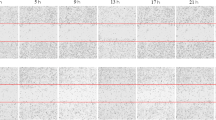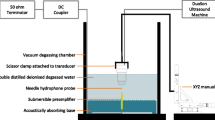Abstract
With the use of lasers for ablation purposes in spinal surgery, the tissue temperature increases above the boiling point of water, leading to tissue ablation by vaporisation. Due to the thermal environment engendered by the use of lasers, there is concern about the safety of the surrounding important structures, such as dura mater, dorsal root ganglia, and nerve roots.
Access this chapter
Tax calculation will be finalised at checkout
Purchases are for personal use only
Similar content being viewed by others
References
Craig E A, Weissman JS and Horwich A L (1994). Heat Shock Proteins and Molecular Chaperones: Mediators of Protein Conformation and Turnover in the Cell. Cell; 78: 365–372.
Garrido C, Gurbuxani S, Ravagnan L and Kroemer G (2001). Heat shock proteins: endo-genous modulators of apoptotic cell death. Biochem Biophys Res Commun; 24: 433–442.
Henderick J P and Hartl F U (1993). Molecular Chaperone Functions of Heat Shock Proteins. Annu Rev Biochem; 62: 349–384.
Marks SCJ and Hermey D C (1996) The structure and development of bone. In: Bilezikian J P, Raisz LG, Rodan G A(eds) Principles of bone biology Academic Press, San Diego, CA ;3–14.
Buckwalter J A, Glimcher MJ, Cooper RR and Recker R (1995) Bone Biology. Part I. Structure, blood supply, cells, matrix and mineralisation. Jour Bone Joint Surg 77-A: 1256–1275.
Andrianarivo A G, Robinson JA, Mann KG and Tracy R P (1992). Growth of type I collagen promotes expression of the osteoblastic phenotype in human osteosarcoma MG-63 cells. Jour Cell Physiol; 153: 256–265.
Price N, Bendall S P, Frondoza C, Jinnah R H and Hungerford D S (1997). Human osteoblast-like cells (MG63) proliferate on a bioactive glass surface. Jour Biomed-Mater Res; 37: 394–400.
Hing, K A, Best SM, Tanner K E, Revell P A and Bonfield W (1998). Histomorphological and biomechanical characterization of calcium phosphates in the osseous environment. Proc Inst Mech Eng H; 212: 437–451.
Malik M A, Puleo D A, Bizios R and Doremus R H (1992). Osteoblasts on hydroxyapatite, alumina and bone surfaces in vitro: morphology during the first two hours of attachment. Biomaterials; 13: 123–128.
Harris S A, Enger R J, Riggs B L and Spelsberg TC (1995). Development and characterization of a conditionally immortalized human fetal osteoblastic cell line. Jour Bone Miner Res; 10: 178–86.
Sudo H, Kodama H A, Amagai Y, Yamamoto S and Kasai S (1983). In vitro differentiation and calcification in a new clonal osteogenic cell line derived from newborn mouse calvaria. Jour Cell Biol; 96: 191–198.
Wieder R (1999). Selection of methods for measuring proliferation. In : Studzinski GP (ed) Cell growth, differentiation and senescence. Oxford University Press, Oxford, UK.
Author information
Authors and Affiliations
Corresponding author
Editor information
Editors and Affiliations
Rights and permissions
Copyright information
© 2012 Springer Science+Business Media, LLC
About this protocol
Cite this protocol
Hafez, M.I., Sandison, A., Coombs, R.R.H., McCarthy, I.D., Hafez, AS.M. (2012). Effects of Temperature Generated from the Holmium: YAG Laser on Human Osteoblasts in Monolayer Tissue Culture. In: Mitry, R., Hughes, R. (eds) Human Cell Culture Protocols. Methods in Molecular Biology, vol 806. Humana Press. https://doi.org/10.1007/978-1-61779-367-7_24
Download citation
DOI: https://doi.org/10.1007/978-1-61779-367-7_24
Published:
Publisher Name: Humana Press
Print ISBN: 978-1-61779-366-0
Online ISBN: 978-1-61779-367-7
eBook Packages: Springer Protocols




